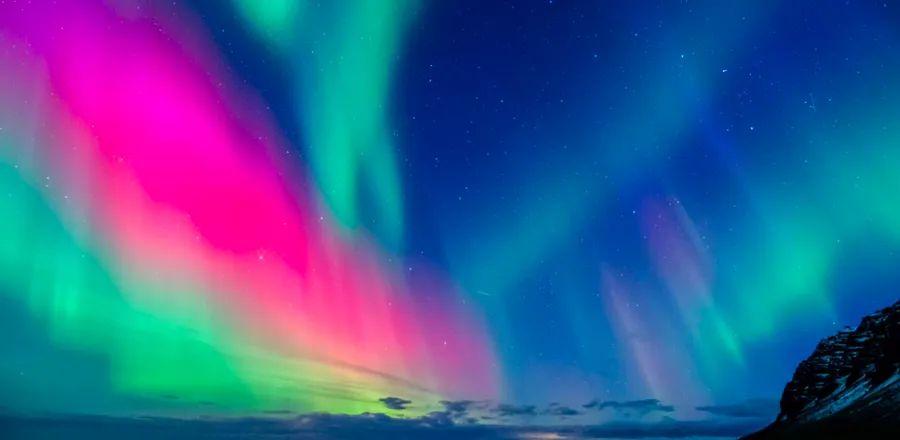Why Northern Lights Viewing Will Be Exceptional in the Coming Years

The cold, clear nights in our northern regions provide the best opportunities to witness the stunning, colorful display of the Northern Lights. With their swirling, flickering movements, the aurora borealis fills the night sky with vibrant shades of chartreuse, magenta, and violet.
The good news is that our chances of experiencing this breathtaking phenomenon will rise over the next three to four years as we near solar maximum, a period when auroral displays are at their most dynamic and brilliant.
Here’s what you should know about the impact of solar maximum on the Northern Lights and tips for experiencing them at their most spectacular.
What exactly does solar maximum mean?
The Northern Lights are generated when the sun emits electrically charged protons and electrons toward Earth. Upon encountering our planet’s magnetic field, these particles are drawn to the polar regions. When they interact with the gases in Earth’s upper atmosphere, the resulting energy is converted into visible light (similar to how neon lights operate).
Although the aurora is present somewhere almost all the time, its intensity can vary. However, during solar maximum, the strength of this celestial display significantly increases.
Every 11 years or so, the sun’s poles flip—its North Pole turns into the South Pole and vice versa. This flip leads to the formation of sunspots (which appear as dark spots on the sun’s surface) and triggers solar flares and coronal mass ejections (CMEs), massive bursts of electromagnetic energy. When these are directed toward Earth, they contribute to the creation of the Northern Lights. As we approach solar maximum (indicated by the month with the highest sunspot count, currently expected around 2025), the frequency and intensity of flares and CMEs will rise.
“It is near solar maximum that we can expect more significant events, where the aurora becomes extremely active and vibrant, extending further from the poles toward the equator, resulting in an expanded auroral oval,” explains Rodney Viereck, a research scientist at the National Oceanic and Atmospheric Administration (NOAA).
Shannon Schmoll, the director of the Abrams Planetarium at Michigan State University, notes that there are currently more sunspots on the sun than initially anticipated, "indicating that it will likely be stronger than the last maximum (which was relatively weak) and potentially one of the most powerful since records began in the 18th century."
Where can I observe the aurora borealis?
Scientists utilize a measurement system known as the Kp Index to assess the chances of witnessing the lights, rated on a scale from zero to nine (with higher numbers indicating more solar activity). Lower readings, such as one or two, suggest that if the auroras appear, they will likely be confined to the Arctic and exhibit more muted hues of white or green. However, when the Kp Index rises to five or six, the area where the lights could be visible expands significantly, allowing sightings as far south as Oregon, Montana, the upper Midwest, and New England. There is also an increased likelihood of witnessing red or violet bands.
To gauge how active the aurora is in your vicinity, you can check short-term aurora forecasts. Rick Tresch Fienberg, a senior contributing editor at Sky and Telescope magazine and a senior advisor at the American Astronomical Society, suggests:
- Space Weather for real-time updates on solar activity (note, it’s quite nerdy)
- The Geophysical Institute at the University of Alaska Fairbanks’ aurora monitor for forecasts over the next 27 days
- NOAA Space Weather Prediction for 30-minute forecasts covering both the Northern and Southern hemispheres
- Mobile applications such as My Aurora Forecast and Auroral Borealis Forecast & Alerts to receive notifications when auroral activity occurs nearby.
When is the best time to plan a Northern Lights adventure?
Researchers indicate that viewing the Northern Lights is generally more favorable around the spring and fall equinoxes. This is primarily due to the Earth’s position during these times. Around the summer and winter solstices, the tilt of the Earth toward or away from the sun is at its peak; however, during the equinoxes, the Earth's axis is aligned so that it is neither tilted toward nor away from the sun (resulting in nearly equal hours of daylight and darkness). This alignment allows for a more effective transfer of energy from the solar wind to the magnetic field, leading to more vivid auroras.
For those aiming to maximize their chances and maintain travel flexibility, it’s important to note that the sun completes a rotation every 27 days. If a spectacular display occurred 27 days prior, there is a higher likelihood of experiencing another impressive show roughly 27 days later.
It’s essential to highlight that while the auroras occur throughout the year, they are not visible during the summer months due to excessive brightness in the Arctic regions.
Advice for witnessing the Northern Lights during solar maximum
Travel as far north as you can
Auroral activity predominantly occurs within a region known as the auroral oval—imagine it as a belt encircling the far northern latitudes. The most vivid displays are typically found between latitudes 65º and 70º North, with locations such as Fairbanks and Coldfoot in Alaska, Jukkasjärvi and Kiruna in Sweden, Rovaniemi and Utsjoki in Finland, Tromsø and Alta in Norway, as well as most areas of Iceland.
"You generally want to gaze northward, but if you venture into northern Canada or Alaska, you can often reach areas where the aurora is directly overhead, providing a spectacular view," says Viereck.
Look for dark skies
The further you distance yourself from cities and their light pollution, the more vibrant the aurora appears. Websites like darkskymap.com and darksky.org can assist you in pinpointing optimal skywatching locations. Seek out places with unobstructed, expansive views of the horizon, such as hilltops.
"A key factor in enhancing the display is to avoid planning your outing during a full moon, as its brightness can wash out the sky and reduce the contrast your eyes perceive," advises Viereck.
Include a few extra days in case of bad weather
Even with the Kp Index reaching a nine, cloudy skies will obstruct your view of the Northern Lights. Planning for a few additional days at your destination can help you avoid disappointment.
Exercise patience
Just as you can't predict exactly when rain will begin, there's no telling when Mother Nature will illuminate the night sky. The aurora may appear for only a few minutes (and possibly return later) or last for hours, so it's wise to dress warmly, bring snacks, and be prepared to stay put while hunting for the lights.
Evaluation :
5/5



